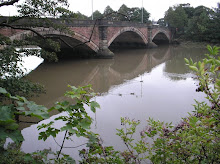If you had been walking down Broadgate in September 1835 you may well have been puzzled as to the amount of activity taking place on both sides of the river. Over the next three years your stroll would have witnessed the building of one of the finest bridges in England.
The North Union Railway Bridge opened in October 1838 to great excitement as it opened the way to a means of travel never before seen. The company that built it was the result of the very first amalgamation of two railway companies – the Wigan Branch Railway and the Wigan and Preston Junction Railway. They joined forces and became the North Union Railway and on the 1st November 1838 the first journey into Preston was accompanied by ‘loud huzzas, the bells sent forth their sonorous peals…and a band of music played’.
I like to think that the cheers were also for the bridge itself which is and was an amazing structure. It was 872 feet long, 28 feet wide and 68 feet above the bed of the river. The cutting at the northern end through ‘The Cliffe’ was 29 foot deep and the embankment on the southern side was forty feet high on a base ninety feet wide and contained 464,431 cubic yards of earth. It contained 675,000 cubic feet of rusticated ashlar brought from quarries in Whittle, Longridge and Lancaster and cost £40,000. I use the past tense as the original bridge has been modified twice, in 1879 and 1904 but it still is recognisably the same structure you can see in the early photos.
In the reference library there is a description of it as being ‘light and elliptical and extremely well built with elliptical arches of a 120 foot span each. From beneath the dry arch on the north side a singular and powerful echo repeated many times is evoked by the utterance of a few words at an ordinary pitch of the voice.’
It was built by the firm of Mullins and Company to a design by Charles Vignoles. And this is where the background reading I was doing on this subject took me off on a branch line. Charles Vignoles was born in 1793 in Ireland, he emigrated to the USA where he became a soldier, later becoming a surveyor and in 1823 returned to England. In 1826 he was working with George Stephenson on the Liverpool and Manchester Railway but they didn’t get on and he left. But after working on our bridge his career really took off and he built the Kiev Bridge over the River Dneiper and the Tudela & Bibao Railway in Spain. He also worked on Ireland’s first railway between Dublin and Kingtown. He became a Member of the Institution of Civil Engineers and its 15th President in 1869 He became a fellow of the Royal Astronomical Society on 9 January 1829. In 1841he had become the first Professor of Civil Engineering at University College, London and in 1855 was elected as a Fellow of the Royal Society and published Observations on the Floridas (1823, with valuable map). He died in 1875 in Hampshire.
A truly amazing man and career. And one of his first works was the bridge on Broadgate.
Subscribe to:
Post Comments (Atom)

















3 comments:
for a pic of the bridge and more on bridge building see
http://mysite.wanadoo-members.co.uk/bridgebuilderpreston/index.htm
Thanks Greg, I removed your first comment because it was almost the same as the second, and the link within it did not work.
Cheers - and a really nice picture.
Post a Comment